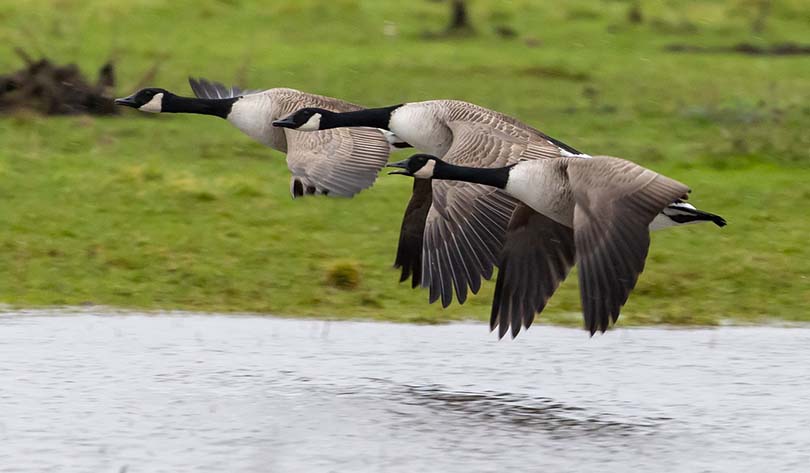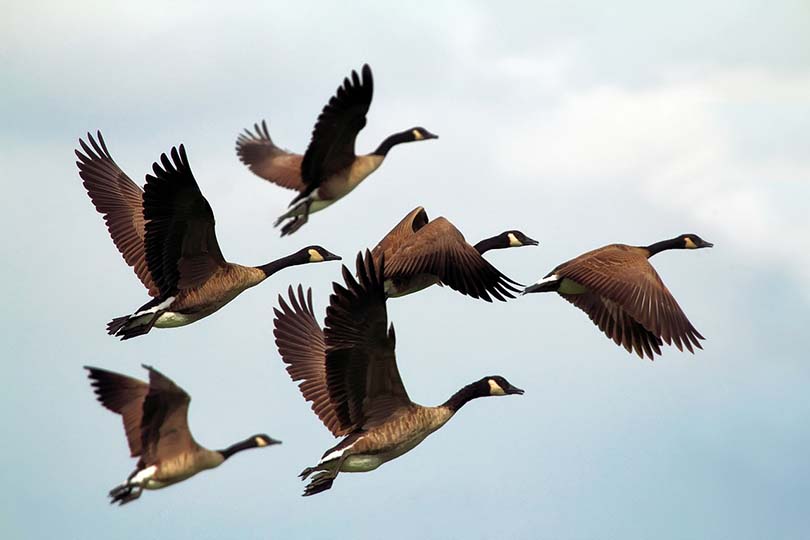Why Do Geese Fly in a V Formation?
Last Updated on

When you hear the honking from a flock of geese, the first thing you probably do is look into the sky and spot that bewildering V formation flying overhead. While almost every flocking bird species does this, geese are some of the most common kinds that come to mind. So, what is the reason for this uniform formation while they travel? The shape helps the birds conserve energy. If you want to better understand that behavior, you have to think about all the factors that affect their energy while they travel.

The V Formation
The V formation, also called the Echelon formation, is common in most migratory birds. Geese essentially get a nice lift from the air when they fly in this formation. The V formation is ideal for the birds that travel long distances and helps each member of the flock save precious energy.
Creating a Wake
Look behind a moving boat and you’ll see that it leaves a wake following it. The same thing happens when a bird is flying through the air. Think about it this way; the part of the wake closest to the boat is uniform and starts to break once it gets further away. The wings of the geese create a type of wake in the air. Unfortunately, the air is less stable than water and produces more chaotic patterns at the end of the wake. By sticking to a V formation, the uniformity and proximity of the birds keep the air from making movement through the air more challenging.
What Happens with Air Pressure?
Air has mass just like anything else. When geese fly, the air gets pushed away from the bird and moves around them. Unlike in a car where the lowest air resistance would be directly behind the moving vehicle, the lowest resistance for flying birds is off to the side. The tips of a goose’s wings create a type of air vortex. The air behind the bird gets pushed upwards, and the air to the side gets pushed upwards.

Who Becomes the Leader?
Being the tip of the V is the most challenging spot in the formation. However, there aren’t any consistent leaders in the shape. Birds tend to take turns being in the front of the V.
Why is One Side of the V Longer than the Other?
You might have noticed that this formation that birds fly in isn’t exactly symmetrical. There is often one side that is a little bit longer than the other. No, this isn’t only because of the number of geese in the flock.
Geese often make one side of their formation longer whenever there is a crosswind. The side with stronger winds is usually longer, and the birds fly straighter behind the leader. The shorter side tends to fly a bit wider because they have fewer members. Birds tend to fly in the direction that they can most easily use the wind to their advantage.
What Other Birds Fly in V Formations?
Geese are what most people think of when they see a V formation flying overhead, but there are many other migratory birds that travel this way as well. Here are some of the most common ones:
- Swans
- Ducks
- Pelicans
- Flamingos
- Cranes
- Ibises

In Conclusion
Geese and all other flying birds have become masters of the air. They can take the wind and air pressure and use it to their advantage in many different ways. It’s incredible that so many animals have become intelligent enough to manipulate their surroundings to their advantage and make life easier. The V formation you see in the sky each year isn’t because the birds care what they look like. Instead, they are simply trying to travel long distances while maintaining their energy in the most efficient way possible.
Featured Image Credit: TheOtherKev, Pixabay
About the Author Hallie Roddy
Hallie is a proud nature and animal enthusiast and has been for as long as she can remember. She attributes her passion for the environment and all its creatures to her childhood when she was showing horses on weekends and spending her weeknights devoting her attention to her pets. When Hallie isn’t using her degree in English with a writing specialization to spread informative knowledge on pets and animals, you can find her snuggled up on the couch reading books or watching nature documentaries with her own pets.
Related Articles:
How to Clean a Refractor Telescope: Step-by-Step Guide
How to Clean a Telescope Eyepiece: Step-by-Step Guide
How to Clean a Rifle Scope: 8 Expert Tips
Monocular vs Telescope: Differences Explained (With Pictures)
What Is a Monocular Used For? 8 Common Functions
How to Clean a Telescope Mirror: 8 Expert Tips
Brightfield vs Phase Contrast Microscopy: The Differences Explained
SkyCamHD Drone Review: Pros, Cons, FAQ, & Verdict
